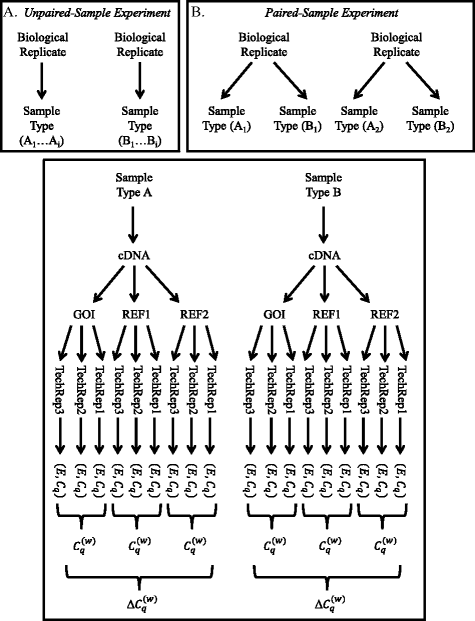A common base method for analysis of qPCR data and the application of simple blocking in qPCR experiments
- PMID: 29191175
- PMCID: PMC5709943
- DOI: 10.1186/s12859-017-1949-5
A common base method for analysis of qPCR data and the application of simple blocking in qPCR experiments
Abstract
Background: qPCR has established itself as the technique of choice for the quantification of gene expression. Procedures for conducting qPCR have received significant attention; however, more rigorous approaches to the statistical analysis of qPCR data are needed.
Results: Here we develop a mathematical model, termed the Common Base Method, for analysis of qPCR data based on threshold cycle values (C q ) and efficiencies of reactions (E). The Common Base Method keeps all calculations in the logscale as long as possible by working with log10(E) ∙ C q , which we call the efficiency-weighted C q value; subsequent statistical analyses are then applied in the logscale. We show how efficiency-weighted C q values may be analyzed using a simple paired or unpaired experimental design and develop blocking methods to help reduce unexplained variation.
Conclusions: The Common Base Method has several advantages. It allows for the incorporation of well-specific efficiencies and multiple reference genes. The method does not necessitate the pairing of samples that must be performed using traditional analysis methods in order to calculate relative expression ratios. Our method is also simple enough to be implemented in any spreadsheet or statistical software without additional scripts or proprietary components.
Keywords: Analysis of variance (ANOVA); Blocking; Confidence intervals; Paired and unpaired tests; Statistics; qPCR analysis.
Conflict of interest statement
Ethics approval and consent to participate
Not applicable.
Consent for publication
Not applicable.
Competing interests
The authors declare that they have no competing interests.
Figures


References
MeSH terms
LinkOut - more resources
Full Text Sources
Other Literature Sources
Miscellaneous

